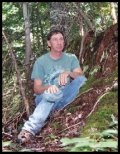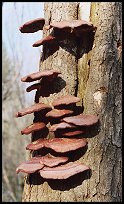|

Dr. Dana Richter
Forest Mycologist
Michigan Technological University
Houghton
dlrichte@mtu.edu

|
Mostly
unnoticed, fungi interact with all phases of the forest--from seedlings
to trees, in the mill and forest products, finally to wood in use. Sometimes
along the way fungi are a benefit, sometimes a detriment. Mycology is
the study of fungi. One who deals with the fungi in the forest and fungi
in wood is a forest pathologist, although only part of the job deals specifically
with tree diseases.
As a forest pathologist I find myself with a wide range of tasks. Principally
I operate a forest microbiology laboratory, since the fungi are essentially
microbes and they do their work microscopically. Using very basic techniques
with Petri plates, agar, and microscopy, fungi can be isolated from trees
or wood in the lab to diagnose disease or the cause of decay or other
wood defect. A large part of the lab work involves wood products testing
and evaluation of new wood preservatives to prevent decay and stain. This
involves maintaining an extensive fungus culture collection with which
to do the testing. All new wood composite products and wood preservatives
must meet certain standards before they can be marketed. My lab is a link
in that chain.
Field work for a forest pathologist is usually conducted in the warmer
months when trees and fungi are active. Usually this involves examination
of a tree or stand to diagnose a disease, or collect samples for lab analysis.
Diseases are natural in forest systems, but those that are destructive
often have some sort of human connection. For example, oak wilt involves
wounding trees in spring and early summer, Armillaria root rot and maple
sapstreak involve root compaction or buttress root damage. I can advise
if your tree is going to survive or what to do to enhance its chances
of survival.
Knowledge of the wild mushrooms is another aspect of forest pathology,
because fruiting bodies of fungi are used to diagnose disease or indicate
the health of a forest. I end up doing a lot of mushroom identification
for people especially interested in eating them. One of the most popular
events is the annual Edible and Poisonous Mushroom Workshop held at the
Ford Forest Center in L’Anse since 1984. When there is time I freely
conduct field trips and give presentations to advance the knowledge of
fungi in ecosystems.
|

![]() TOP
Press arrow to return to
the top of this page.
TOP
Press arrow to return to
the top of this page.